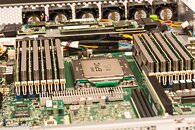
Intel Xeon Scalable Gets a Rebrand: Intel "Xeon 6" with Granite Rapids and Sierra Forest Start a New Naming Scheme
During the Vision 2024 event, Intel announced that its upcoming Xeon processors will be branded under the new "Xeon 6" moniker. This rebranding effort aims to simplify the company's product stack and align with the recent changes made to its consumer CPU naming scheme. In contrast to the previous "x Generation Xeon Scalable", the new branding aims to simplify the product family. The highly anticipated Sierra Forest and Granite Ridge chips will be the first processors to bear the Xeon 6 branding, and they are set to launch in the coming months. Intel has confirmed that Sierra Forest, designed entirely with efficiency cores (E-cores), remains on track for release this quarter. Supermicro has already announced early availability and remote testing programs for these chips. Intel's Sierra Forest is set to deliver a substantial leap in performance. According to the company, it will offer a 2.4X improvement in performance per watt and a staggering 2.7X better performance per rack compared to the previous generation. This means that 72 Sierra Forest server racks will provide the same performance as 200 racks equipped with older second-gen Xeon CPUs, leading to significant power savings and a boost in overall efficiency for data centers upgrading their system.
Intel has also teased an exciting feature in its forthcoming Granite Ridge processors-support for the MXFP4 data format. This new precision format, backed by the Open Compute Project (OCP) and major industry players like NVIDIA, AMD, and Arm, promises to revolutionize performance. It could reduce next-token latency by up to 6.5X compared to fourth-gen Xeons using FP16. Additionally, Intel stated that Granite Ridge will be capable of running 70 billion parameter Llama-2 models, a capability that could open up new possibilities in data processing. Intel claims that 70 billion 4-bit models run entirely on Xeon in just 86 milliseconds. While Sierra Forest is slated for this quarter, Intel has not provided a specific launch timeline for Granite Ridge, stating only that it will arrive "soon after" its E-core counterpart. The Xeon 6 branding aims to simplify the product stack and clarify customer performance tiers as the company gears up for these major releases.
Intel has also teased an exciting feature in its forthcoming Granite Ridge processors-support for the MXFP4 data format. This new precision format, backed by the Open Compute Project (OCP) and major industry players like NVIDIA, AMD, and Arm, promises to revolutionize performance. It could reduce next-token latency by up to 6.5X compared to fourth-gen Xeons using FP16. Additionally, Intel stated that Granite Ridge will be capable of running 70 billion parameter Llama-2 models, a capability that could open up new possibilities in data processing. Intel claims that 70 billion 4-bit models run entirely on Xeon in just 86 milliseconds. While Sierra Forest is slated for this quarter, Intel has not provided a specific launch timeline for Granite Ridge, stating only that it will arrive "soon after" its E-core counterpart. The Xeon 6 branding aims to simplify the product stack and clarify customer performance tiers as the company gears up for these major releases.


















